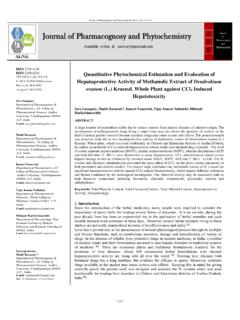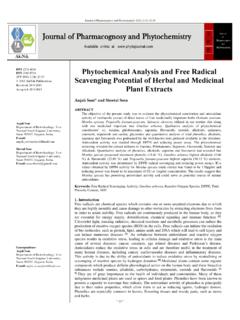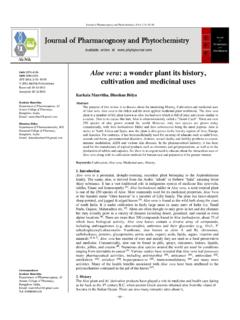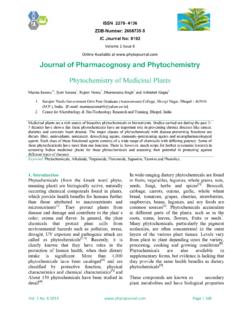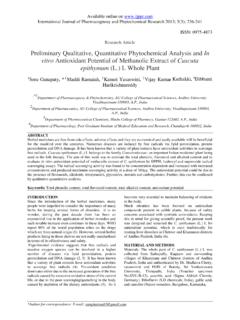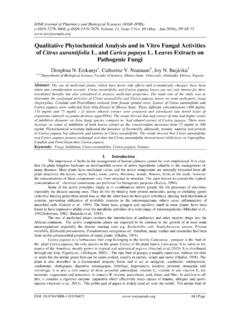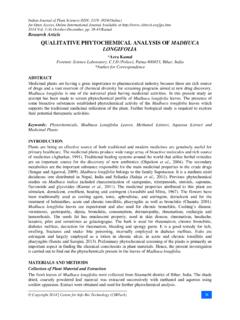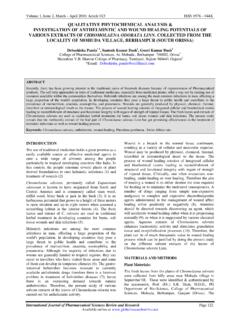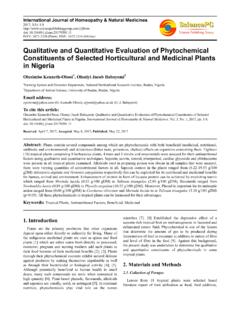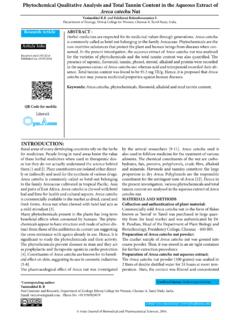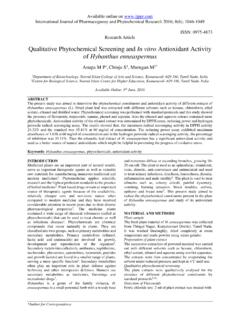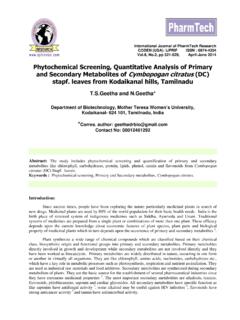Transcription of Qualitative phytochemical analysis of triphala extracts
1 ~ 248 ~ Journal of Pharmacognosy and Phytochemistry 2017; 6(3): 248-251 E-ISSN: 2278-4136 P-ISSN: 2349-8234 JPP 2017; 6(3): 248-251 Received: 14-03-2017 Accepted: 15-04-2017 Dr. Neethu S Kumar Post Graduate Department and Research Centre of Botany, Mahatma Gandhi College, Affiliated to University of Kerala, Kesavadasapuram, Thiruvananthapuram, Kerala, India Arun S Nair Post Graduate Department and Research Centre of Botany, Mahatma Gandhi College, Affiliated to University of Kerala, Kesavadasapuram, Thiruvananthapuram, Kerala, India Megha Murali Post Graduate Department and Research Centre of Botany, Mahatma Gandhi College, Affiliated to University of Kerala, Kesavadasapuram, Thiruvananthapuram, Kerala, India Sreeja Devi PS Post Graduate Department and Research Centre of Botany, Mahatma Gandhi College, Affiliated to University of Kerala, Kesavadasapuram.
2 Thiruvananthapuram, Kerala, India Correspondence Dr. Neethu S Kumar Post Graduate Department and Research Centre of Botany, Mahatma Gandhi College, Affiliated to University of Kerala, Kesavadasapuram, Thiruvananthapuram, Kerala, India Qualitative phytochemical analysis of triphala extracts Dr. Neethu S Kumar, Arun S Nair, Megha Murali and Sreeja Devi PS Abstract triphala (tri = three and phala = fruits), is an ayurvedic preparation composed of three equal proportions of herbal fruits native to the Indian subcontinent: viz. Terminalia chebula, Phyllanthus emblica, and Terminalia belerica. triphala is a tridoshic rasayana having a balancing and rejuvenating effect on the three constitutional elements that govern the human life.
3 triphala is rich in antioxidants, possess antibacterial, anti-viral and anti-cancer properties. triphala is also known to cure cataract and effective in the treatment of Acquired immune deficiency syndrome (AIDS). The present study intends to provide an overview of the chemical constituents present in the crude extracts of dried powdered triphala with special emphasis on their pharmacological actions. The powdered triphala extracts have been screened for phytochemical constituents in five different solvents as water, acetone, chloroform, methanol and ethanol. Preliminary phytochemical analysis revealed the presence of ten compounds such as carbohydrates, tannins, steroids, terpenoids, alkaloids, flavanoids, cardiac glycosides, saponins, coumarins etc.
4 phytochemical analysis of the samples were more positive for acetone and ethanol extracts . The results suggest that triphala are a rich source of valuable primary and secondary metabolites which make triphala one of the most valuable herbal preparations in the world. Keywords: triphala , Ayurveda, Rasayana drug, Qualitative , phytochemical analysis 1. Introduction Ayurveda is india s traditional natural system of medicine that has been practiced for more than 5000 years and is often called Mother of all healing . Ayurveda is a Sanskrit word that literally means science of life or practices of longevity . Ayurveda was the system of health care conceived and developed by the rishis and natural scientists through centuries of observations, experiments, discussions and meditations.
5 For several thousands of years their teachings were passed on orally from teacher to student and about the fifth to sixth century BC, elaborately detailed texts were written in Sanskrit, the ancient language of India. For many years Ayurveda flourished and was used by rich and poor in India and South-East Asia. In ayurveda, triphala is a well-known poly herbal formulation. In Indian system of medicine (ISM) it is a rasayana drug [1]. triphala is a mixture of the dried powders of three fruits such as Emblica officinalis Garetn (Euphorbiaceae), Terminalia belerica Linn (Combretaceae) and Terminalia chebula (Combretaceae) in equal proportions. triphala is one among the ayurvedic medicinal herbal formulation mostly preferred by medical practicioners [2].
6 It can be used by all people irrespective of their age. In ayurveda it is described as a tridoshic rasayana that can balance and rejuvenate the three constitutional elements that govern human life ie; vata, pitta and kapha. It has various applications in medical field like laxative, eye rejuvenator, anti- inflammatory, antiviral and so on. It is also effective in headache, dyspepsia, ascites, and leucorrhea, also used as a blood purifier and possess anti- inflammatory, analgesic, antiarthritic, hypoglycemic and anti -aging properties. triphala is claimed to have antiviral and antibacterial effect [3]. triphala is prescribed for fatigue, assimilation, reduces oxidative stress and infectious diseases such as tuberculosis, pneumonia, AIDS, periodontal diseases etc [4].
7 triphala is reported to reduce considerably the damage due to oxidative stress [5]. Studies show that it inhibits the growth of Gram-positive and Gram-negative bacteria [6]. The recent studies prove that triphala is rich in gallic acid, vitamin C, ellagic acid, chebulic acid, bellaricanin, beta sitosterol and flavanoids [7]. Laboratory and clinical studies on ayurvedic herbal preparations and other therapies have shown them to have a wide range of potentially beneficial effects for preventing and treating various diseases. Mechanisms underlying these effects may include free radical scavenging effects, immune system modulation, brain neurotransmitter modulation, hormonal effects etc.
8 Development of new diseases always insist humans in need of new drugs. So since ancient times, people have been exploring nature s immense plant wealth in search of new drug and thus provided us a huge wealth of medicinal plants with versatile pharmacological properties. ~ 249 ~ Journal of Pharmacognosy and Phytochemistry Nearly 80% of the world s population relies on traditional medicines for primary health care, most of which involve the use of plant extracts [8]. In India, almost 95% of the prescriptions were plant based in the traditional systems of Unani, Ayurveda, Homeopathy and Siddha [9]. The failure of chemotherapeutics and the increasing potential of pathogens against antibiotics pressured the researchers for the screening of several medicinal plants for their eminent pharmacological activities.
9 Phytochemistry is the study of phyochemicals, which are chemicals derived from plants. Specifically phytohemistry describes that large number of secondary metabolic compounds found in plants. In present days, secondary metabolites have been extensively investigated as a source of medicinal agents. About 1500 plants with medicinal uses are mentioned in ancient text and around 800 plants have been used in traditional large number of secondary metabolic compounds are found in plants. Many of these are known to provide protection against plant diseases and insect attack. Literature of many research works prove that triphala is an excellent drug with versatile medicinal property.
10 triphala has been described in the ancient Ayurvedic test as a Tridoshic Rasayana, a therapeutic agent with balancing and rejuvenating effects on the three constitutional elements in Ayurveda -vata, pitta and kapha. Terminalia chebula Retz. And Terminalia bellerica Roxb. Have a warm energy, while Emblica officinalis Gaertn. Is cool in nature. triphala , being a combination of all three, is therefore balanced, making it useful as an internal cleansing, detoxifying formula. It is regarded as an important Rasayana and good purgative in Ayurvedic medicine. Recipe for this traditional herbal supplement is described in the traditional Indian tests, the Charaka and Susruta Samhita.
